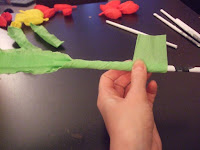For my keyring book I chose the theme "reasons I'm glad you're in my life". You can choose any theme you want for the book, such as "reasons I love you", "precious memories", "our first year together", "funny moments" and so on.
For birthdays or anniversaries you could number the book by age or how long you have been with the person you are giving this gift to. I did exactly that, choosing 29 pages: one for each year of my boyfriend's life.
You will need a set of old playing cards that you no longer need, a hole punch, a keyring*, scissors, glue, card or colour paper, colour pens and bits and bobs to decorate your book with, such as stickers, print outs of photos and memorabilia of your life with the person you're giving the gift to such as cinema tickets, airline tickets, cards you've kept from them and so on.
*If you're using a lot of cards, ring binder rings are probably better.
Since I had chosen to make my book 29 pages long, I used 16 cards in total: 15 ( for the pages of the book and the back cover and 1 for the front cover and title page).
I've seen people do similar projects on various websites using a pack of playing cards which they stick things directly onto. That is certainly easier, but I wanted to make my book a bit different and I didn't have proper playing cards, so I decided to glue colour card and brown envelope paper onto my cards instead to give it a unique look.
Depending on the person's taste you could make your book look very different using gift wrapping paper with different patterns; just make sure that it properly overs up the playing card underneath.
First I traced around the edge of the playing cards on different pieces of card and paper, cut out the outlines and glued them down using a normal glue stick.
I placed each one under a heavy book as it dried.
Then I made a hole at the corner of each card, making sure the holes were all placed in the same spot by using the size guide on the hole punch.
I have seen other people make two holes and use ring-binder rings instead for a more conventional book look but I liked the look of the one hole at the top, and it was easier to make sure all the holes were in line.
I carefully attached each one to the keyring, making sure not to rip any of the paper as I did so.
I made sure that I wrote down a draft of the 29 things I wanted to write before starting so that I could make sure not to make any silly errors in spelling. It was helpful to do this to be clear exactly what I wanted to write. This was also really useful in deciding what order to write everything in and where to place the pictures I had printed out.
I scanned in to my computer cinema tickets, train tickets, photographs and drawings which I associate with the 29 reasons I'm glad he's in my life (such as "we share a love of books" and a picture of him browsing a book market). I copied the pictures into a Word document, using that to make some of the photos a little brighter in colour, cropping them and shrinking them all down to the correct size. I made sure I had the page at 100% size to get a good idea of how big the images would be once printed and held up the cards to the screen to make sure non of the pictures were too big.
I then set about decorating the book with the printed pictures and stickers. I numbered the pages too.
As I had one too many sides for the book I made a front cover and then the title page on the back of it.

To finish off I made an origami box big enough to wrap it in and cut small pieces of crepe paper to fill out the box.




































































